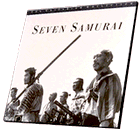

Japan film school
1954
bw 203 min.
Director: Akira Kurosawa
CAV: out-of-print collectible
4 discs, catalog # CC1167L
CLV: $59.95 - available
2 discs, catalog # CC1236L
DVD: $39.95 - available
1 disc, catalog # SEV040
VHS: available from Home Vision Cinema

Breathtaking,
fast-moving, and overflowing with a delightfully selfmocking sense of
humor, Akira Kurosawa's Seven Samurai is one of the most
popular and influential Japanese films ever made. Released in 1954,
this rip-snorting action-adventure epic about a 16th-century farm
community led by a band of samurai warriors defending itself from a
marauding army, sparked not only an American remake, The
Magnificent Seven (1960), but went on to influence a score of
other westerns, particularly those of Sam Peckinpah (The Wild
Bunch) and Sergio Leone (The Good, the Bad and the Ugly and
Once Upon a Time in the West). But to hear it from director
Kurosawa, the most important inroad Seven Samurai made was on
home turf.
"Japanese films all tend to be rather bland in flavor,
like green tea over rice," Kurosawa remarked in an interview, making a
knowing dig at his staid rival, Yasujiro Ozu (one of whose films was
actually called The Flavor of Green Tea Over Rice). "I think we
ought to have richer foods, and richer films. So I thought I would
make this kind of film entertaining enough to eat."
The dish
Kurosawa set before audiences was certainly different from what they
had tasted up until then -- particularly as far as period filmmaking
was concerned. Instead of the slow, ritualistic, and highly theatrical
style of the typical 16th-century saga, Seven Samurai moved
with the sure swiftness of a Hollywood action epic, like Gunga
Din or Stagecoach. The characters may inhabit historical
settings, but their manner and bearing were, often as not, strikingly
contemporary -- particularly in the case of the buffoonish Kikuchiyo,
the high-spirited would-be samurai played with great gusto by Toshiro
Mifune. Most important of all was the visual style of the film which,
thanks to Kurosawa's use of multiple cameras, lent itself to many
unusual editing techniques.
In the atmospheric opening scene, for
example, the camera cuts closer and closer to a group of cowering
villagers, dramatically underscoring their situation with deft
simplicity. An audacious use of slow motion in the sword fight scenes
of Chapters 4 and 7 give them a highly sophisticated drama tic
charge. And that's not to mention the climactic battle scenes
(Chapters 23, 25, and 28), whose brilliant staging and heart-stopping
pace rival the finest work of Griffith, Gance, and Eisenstein.
But
over and above these select bits of brilliance stands Kurosawa's
storytelling style. The film may be over three hours in length, but
the pace never flags, because the director at the helm has an uncanny
sense of assurance in varying the action's flow. We're never retracing
old dramatic ground: rather, we're always moving forward.
Kurosawa
wastes little time in setting up his premise. It's essentially there
in the film's opening shot -- an ominous vista of horses galloping
against the horizon at daybreak. Once the villagers state their plight
and decide the course of action they have to take, the film is off and
running, as they go looking for the samurai warriors they'll need to
help them. This situation quickly devolves into a series of vivid
dramatic turns, as we meet each of the chosen samurai, and their
leader (the great Takashi Shimura) sets about planning the strategy
the villagers will need to fight the army.
It is at this juncture
that Kurosawa adds a special flavor to the proceedings that sets them
apart from any action film ever made. For the story of Seven
Samurai isn't one of simple "Good" versus "Evil," as we learn when
we're told that these villagers have, in the past, preyed on the very
class of samurai they're now asking for help. And why are these
samurai helping them, for virtually no pay, and with only a few
handfuls of rice for food? Why, for the adventure of it all, of
course. These men have seen many battles, but only in this one will
they be truly able to test themselves. There's no reward, and the odds
against their winning are a good one hundred to one -- and that's
exactly why they want to stay and fight. For these seasoned warriors
long to experience that very personal sense of "honor" so prized by
the Japanese.
Watching this raggle-taggle band of fighters defend
the village makes for a climax as stirring as ever seen on a motion
picture screen. But it's only one part of an epic movie meal that is
every bit as delicious as its filmmaker chef had planned.
-- DAVID
EHRENSTEIN
Credits
Director: Akira Kurosawa
Production: Sojiro Motoki
Screenplay: Akira Kurosawa, Shinobu
Hashimoto, Hideo Oguni
Photography: Asaichi Nakai
Art Direction:
So Matsuyama
Music: Fumio Hayasaka
Assistant Director: Hiromichi
Horikawa
Editing Manager: Hiroshi Nezu
Historical Research:
Kohei Ezaki (folklore), Yoshio Sugino (fencing), Ienori Kaneko
(archery), Shigeru Endo (archery)
Transfer
This edition
of Seven Samurai was made from a new, unsubtitled 35mm print,
struck from the restored Japanese negative. Subtitles were added
electronically. The letters are faintly outlined in black to make them
more readable against the very white scenes in this film. A new and
more contemporary translation was prepared.







